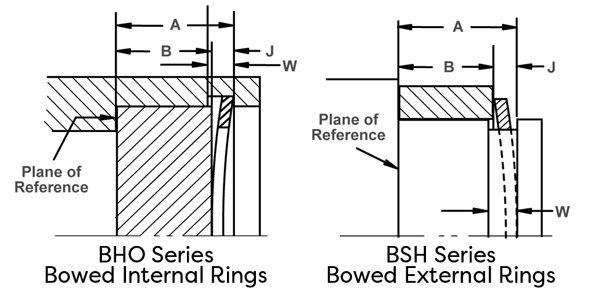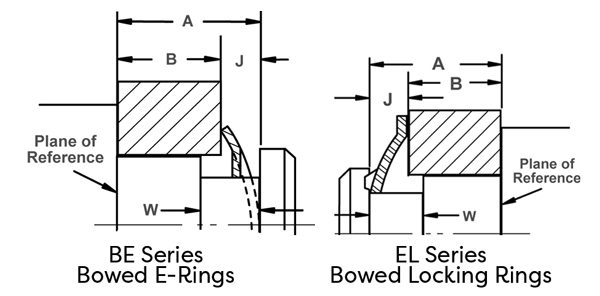Formulas: Bowed Retaining Rings
SERIES BHO, BSH, BE and EL RINGS
To obtain the maximum resilient end-play take-up which bowed rings offer, it is necessary to locate grooves carefully. Formulas for calculating the location of the load-bearing wall of the groove with respect to any plane of reference are as follows:
A max = B min + J max
A min = B max + J min
J max – J min. = resilient take-up of tolerances of groove location A and width B of retained part (see drawings below.)


The thickness tolerance, residual bow height and minimum bow height of the ring are used to determine the J min and J max spacing dimensions.
In cases where the tolerances of width B of the retained part are large, the tolerances of groove location A will be small. In many cases, groove width W has no effect on ring function provided it is larger than the listed minimum. The groove width may be increased considerably, in fact, with no effect on ring function as long as the rear wall of the groove remains under the retained part.
J min and J max, the dimensions used to control groove location, are set so that the rings will not flatten completely during installation. Even after flattening under the load listed in the data charts as “Force Needed to Flatten,” the rings will retain sufficient bow height to take up end-play resiliently within the limits of J min and J max.
Series BHO, BSH and BE bowed rings will retain their tight grip against the groove bottom even under loads exceeding the “Force Needed to Flatten” and will then provide thrust load capacities equivalent to the corresponding flat standard internal and external rings.
More than Parts. A True Partnership.
Our passion is creating the best rings, springs, and clamps. Our mission is to make your work a success. We are here for you.
